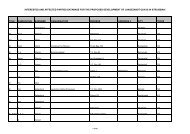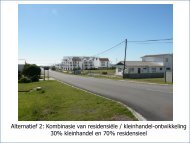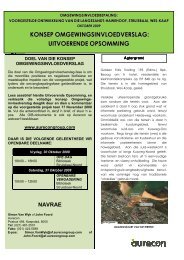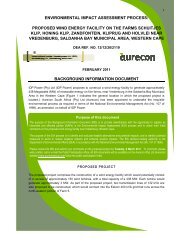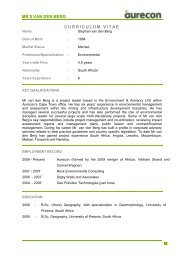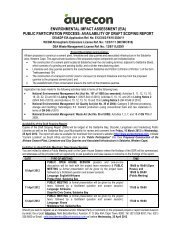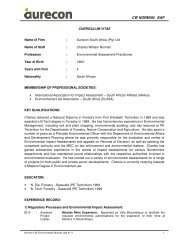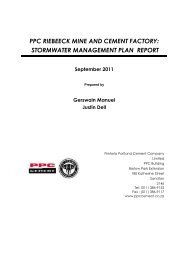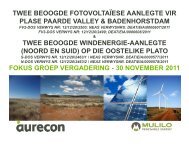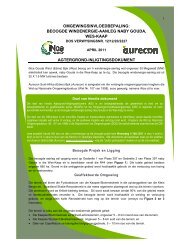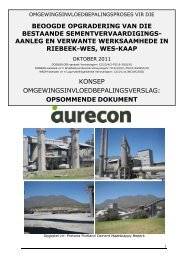Final EIAR - Aurecon AME Environmental | Environmental Projects
Final EIAR - Aurecon AME Environmental | Environmental Projects
Final EIAR - Aurecon AME Environmental | Environmental Projects
You also want an ePaper? Increase the reach of your titles
YUMPU automatically turns print PDFs into web optimized ePapers that Google loves.
Proposed Wind and Solar (Photovoltaic) Energy Facilities on Kangnas Farm near Springbok in the Northern Cape: Draft EIR 66<br />
Eagle and Ludwig’s Bustard in the solar focus areas. The birds of greatest potential relevance<br />
and importance in terms of possible impacts relative to the proposed wind energy facility are<br />
likely to be (a) resident and breeding raptors, notably Martial Eagle Polemaetus bellicosus,<br />
Verreaux’s Eagle Aquila verreauxii, Cape Eagle-Owl Bubo capensis and possibly Jackal<br />
Buzzard Buteo rufofuscus; (b) large terrestrial birds and raptors nesting, foraging on, or moving<br />
over, the lowland/plateau interface, including Booted Eagle Aquila pennatus, Southern Palechanting<br />
Goshawk Melierax canorus, Black-chested Snake-Eagle Circaetus pectoralis, Ludwig’s<br />
Bustard Neotis ludwigii, Blue Crane Anthropoides paradiseus and possibly Black Harrier Circus<br />
maurus (c) endemic passerines that utilise the ridge lines (Fairy Flycatcher Stenostira scita and<br />
most likely African Rock Pipit Anthus crenatus and (d) flocks of waterbirds moving between the<br />
wetlands (farm dams and pans) in and around the development sites, notably Greater Flamingo<br />
Phoenicopterus ruber and various duck species.<br />
b) Potential Impacts<br />
Wind Energy Facility Potential Impacts<br />
The potential impacts on the avifauna of the site includes displacement and disturbance of<br />
resident or breeding Karoo species, large terrestrial birds, resident or migrant raptor species,<br />
aerial species and/or mortality of these species caused by collision with the wind turbine blades<br />
or power lines, habitat loss, electrocution on new power infrastructure as well as behavioural<br />
displacement (alteration of flight paths).<br />
Overall the most important species include (i) Resident and breeding raptors, especially<br />
Verreaux’s Eagle (at least one pair was seen and possibly breeding in the footprint area of the<br />
solar focus area) Secretarybird (a known nest site just north of the footprint area of the revised<br />
wind turbine layout), Martial Eagle, Rock Kestrel and Southern Pale-chanting Goshawk ,(ii)<br />
large terrestrial bird species, especially Ludwig’s Bustard, Kori Bustard and Karoo Korhaan (iii)<br />
Populations of localised/range-restricted or biome-restricted species particularly Red Lark,<br />
Stark’s Lark, Karoo Lark and Sickle-winged Chat.<br />
Collisions with turbines and power lines<br />
The number of collisions of birds with turbines and power lines ranges from low to high across<br />
countries and the world. Although collision rates may appear relatively low in many cases,<br />
cumulative effects over time, especially when considered for large, long lived, slow reproducing<br />
and/or threatened species (many of which are collision-prone), may be of considerable<br />
significance.<br />
Many factors influence the number of birds killed at wind energy facilities. These can be<br />
classified into three broad groupings: (i) avian variables, (ii) location variables, and (iii) facilityrelated<br />
variables. It is logical to assume that the more birds there are flying through a site, the<br />
higher the chances of a collision occurring. The types of birds present in the area are also very<br />
important as some species are more vulnerable to collision with turbines and power lines than<br />
others. Species-specific variation in behaviour, from general levels of activity to particular<br />
foraging or commuting strategies, also affect susceptibility to collision. There may also be<br />
seasonal and temporal differences in behaviour, for example breeding males displaying may be<br />
particularly at risk.<br />
© <strong>Aurecon</strong> (2012) No unauthorised reproduction, copy<br />
or adaptation, in whole or in part, may be made.<br />
P:\<strong>Projects</strong>\108495 Kangnas WEF & PV EIA's\3 Project Delivery\4 Reports\FEIR\FEIR 210213 <strong>Final</strong>.doc


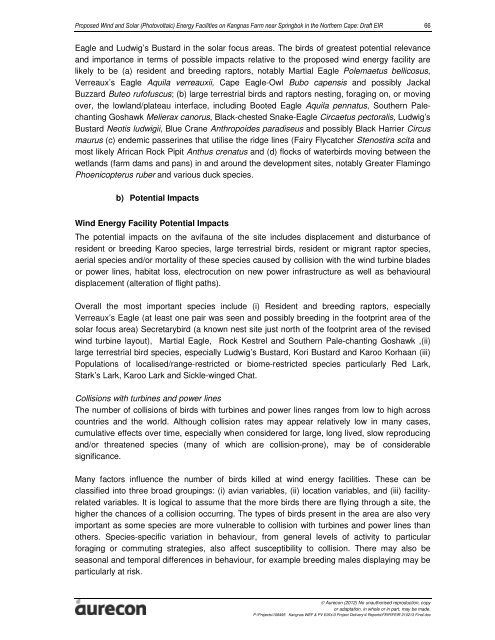
![CRR IV FEIR ~ 26042010 [FINAL].pdf - Environmental Projects](https://img.yumpu.com/21973020/1/184x260/crr-iv-feir-26042010-finalpdf-environmental-projects.jpg?quality=85)
